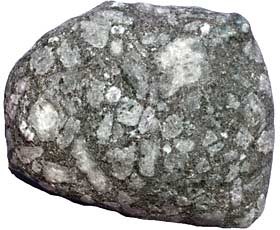
Where does diabase form? Diabase is an intrusive igneous rock with the same mineral composition as basalt. It cools under basaltic volcanoes, like those at mid-ocean ridges. Diabase cools moderately quickly when magma moves up into fractures and weak zones below a volcano. There, it forms dikes (tabular igneous rock bodies that cut across pre-existing rock layers or bodies) or sills (tabular igneous rock bodies that form parallel to pre-existing rock layers). The moderate cooling rate allows small visible crystals to form in the rock.
Why does the diabase have large and small crystals? Igneous rock with some large crystals among the smaller crystals is called a porphyry. The different crystal sizes are the result of different rates of cooling as the magma body moved upward. The large crystals, called phenocrysts, in diabase are feldspar crystals that grew as the magma cooled slowly deep in a magma chamber. Later the magma with the large phenocrysts moved upward quickly, causing more rapid cooling of the rest of the magma and the formation of the small crystals that make up the rest of the rock. 
|
Last updated: February 28, 2015
